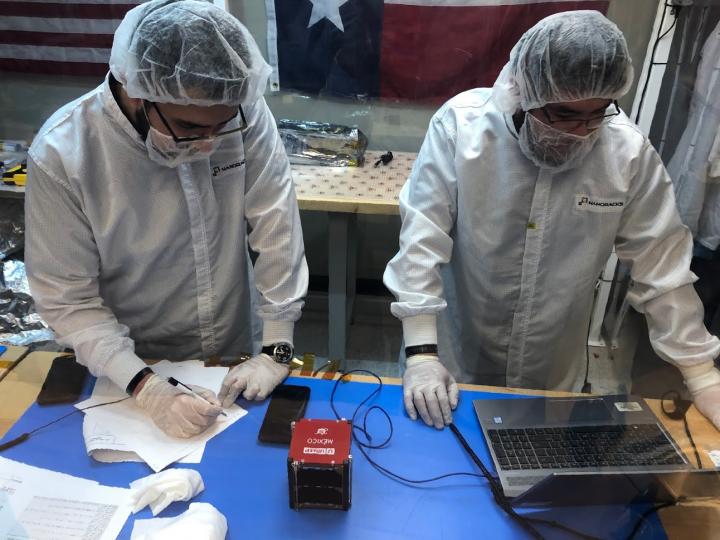The first satellite built by students in Mexico for launch from the International Space Station is smaller than a shoebox but represents a big step for its builders

Credit: NASA
The first satellite built by students in Mexico for launch from the International Space Station is smaller than a shoebox but represents a big step for its builders.
The project is part of NASA’s CubeSat Launch Initiative, which offers universities, high schools and non-profit organizations the opportunity to fly small satellites. Innovative technology partnerships keep down the cost, providing students a way to obtain hands-on experience developing flight hardware.
A multidisciplinary team of students at Universidad Popular Autónoma del Estado de Puebla (UPAEP), in Puebla, Mexico, built the CubeSat for AzTechSat-1. The investigation demonstrates communication within a satellite network in low-Earth orbit. Such Intra-satellite communication could reduce the need for ground stations, lowering the cost and increasing the number of data downloads possible for satellite applications.
“For UPAEP to be the pioneer university working with NASA and launching the first Mexican nanosatellite from the space station is a point of great pride,” said UPAEP faculty member Erika del Carmen Sevilla García. “It motivates students to believe in themselves and exploit their capabilities to the fullest.”
Francisco Fernando Eugenio Urrutia Albisua, a vicerrector or vice president at UPAEP, pointed out that the program is important for the university and for the country. “For Mexico, I hope this will lead to future research and telecommunications projects involving universities or new emerging companies. For UPAEP, it is an honor to be the first university in Mexico to design and build a nanosatellite for flight on the space station.”
According to UPAEP faculty member Maria de la Luz Garcia Cruz, the high-level project represents the start of a new era in Mexico. It also provides inspiration and teaches valuable skills to the students, teachers, and scientists involved.
“For a project such as building a nanosatellite, teamwork is crucial,” said student team member Rosa Reyna Gonzalez Cancino. “Everybody’s work must be valued and appreciated. Project management is the main step for successfully completing any project, no matter how big or small.” An engineering major, she hopes to work on a second AzTechSat mission and eventually seek a job related to satellites or space projects.
The project provided opportunities for students outside of engineering as well. Ana Belen Urrutia Bartsch, a UPAEP student in film and production, is part of a team creating a documentary of the effort. “I learned that big projects like this require a lot of planning and organization time, and a great team of people who work hard on it,” she said. She plans to pursue a master’s degree in cinematography and work in the film industry in Mexico.
Everyone involved in the project looks forward to seeing it launch from historic Cape Canaveral. “Since I was a kid, space exploration and research represented something very special and exciting,” said Eugenio Urrutia. “I never thought to be part of it, even in a modest project like ours.”
“The aerospace industry in Mexico is growing in a very important way, but investments are coming mostly from foreign countries,” he added. “This nanosatellite shows a way to create a domestic industry to collaborate and compete with companies around the world.”
Garcia Cruz notes that the alliances the project created between several academic institutions and private companies provides a path for future projects. “This satellite is promoting the aerospace industry in Mexico.”
AzTechSat-1 uses two onboard communication systems, a modem to communicate with a Globalstar Satellite and an ultra-high frequency (UHF) transmitter-receiver. The experiment uses this hardware configuration to build on previous similar tests and contribute additional data on intra-satellite communication to the community of small satellite developers.
The experiment travels to the space station on the 19th SpaceX Commercial Resupply Services (CRS-19) contract mission for NASA integrated within a NanoRacks CubeSat Deployer (NRCSD) and launches from the JEM Small Satellite Orbital Deployer (J-SSOD). The J-SSOD is handled by the Japan Aerospace Exploration Agency (JAXA) Multi-Purpose Experiment Platform (MPEP) outside the space station.
Inter-satellite communication is critical to future human space exploration. In addition, its reduced cost and increased data capability could improve many satellite-based services used by people on Earth. Size may be the only thing small about a CubeSat.
###
Media Contact
Courtney Beasley
[email protected]
281-483-5111
Original Source
http://www.




